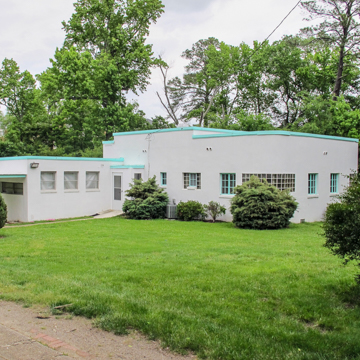One dramatic exception to Virginia State University's mostly Georgian Revival buildings is the modernist residence and studio Meredith designed for herself. One of the commonwealth's earliest known Black female architects, she also founded the college's Fine Arts Department in the 1930s. Her concrete-block house, finished in white stucco, has clean geometric forms, a flat roof, and curving bands of glass-block windows emphasizing the rounded corners of the walls. On the west side of the house, the former garage was enclosed in the 1950s for use as a studio and darkroom. Attached to the studio is an open carport with modernism's favored inverted-V pipes as supports. Inside, the colorful interior has a massive Art Deco fireplace, bright mosaics, Carrara glass, and turquoise vinyl tile with metallic gold flecks.
Meredith resided in the house with her partner and fellow educator, Dr. Edna Meade Colson, until her death in 1984. After Colson's death in 1986, the university acquired the property and it now houses the VSU Alumni Association.
References
Amaza Lee Meredith Papers, 1912, 1930-1930, Accession #1982-20, Special Collections Dept., Johnson Memorial Library, Virginia State University, Petersburg, Va.

